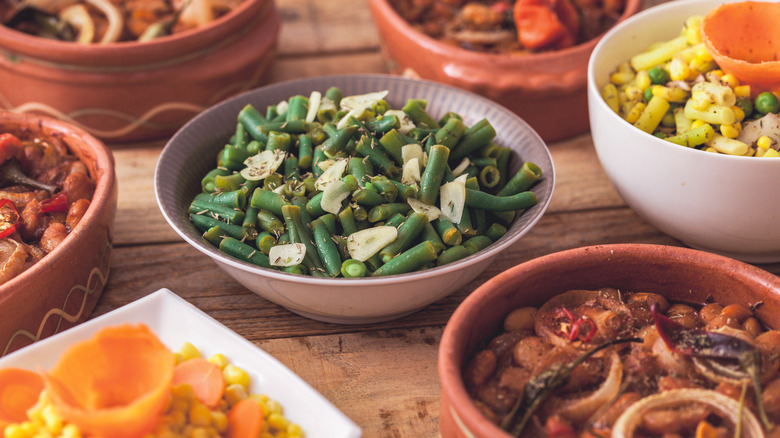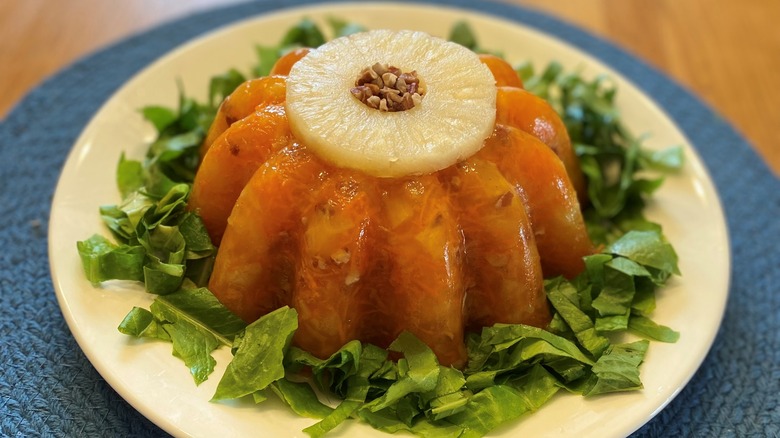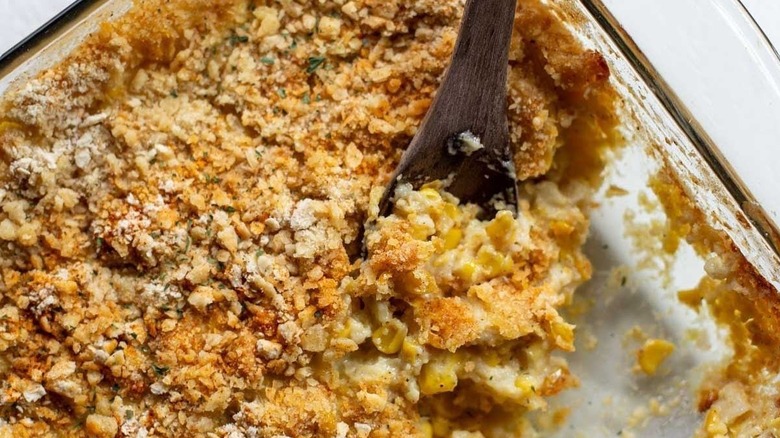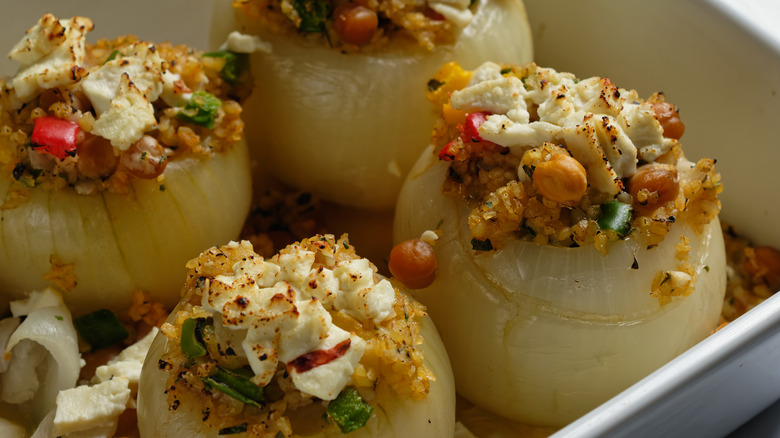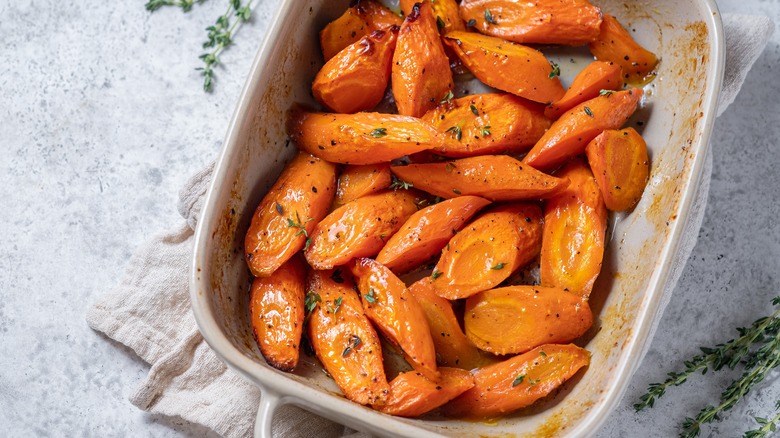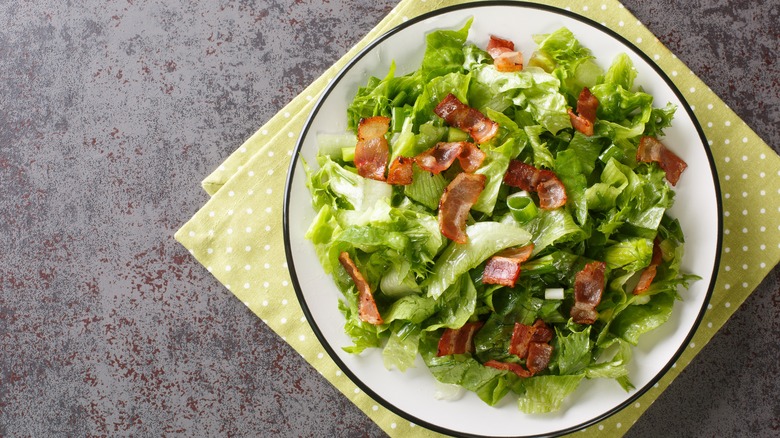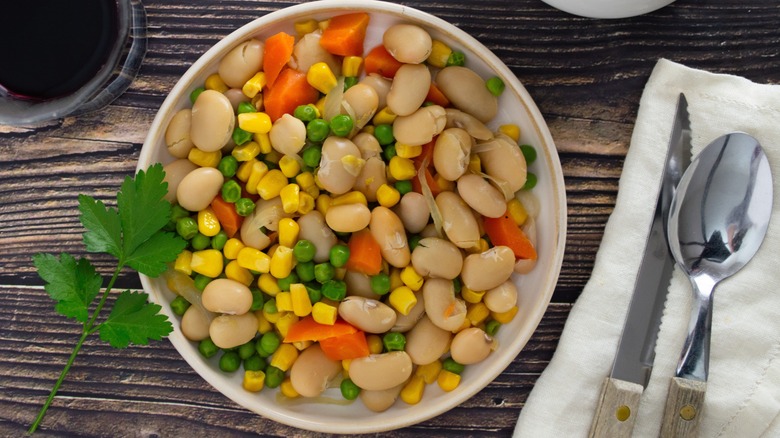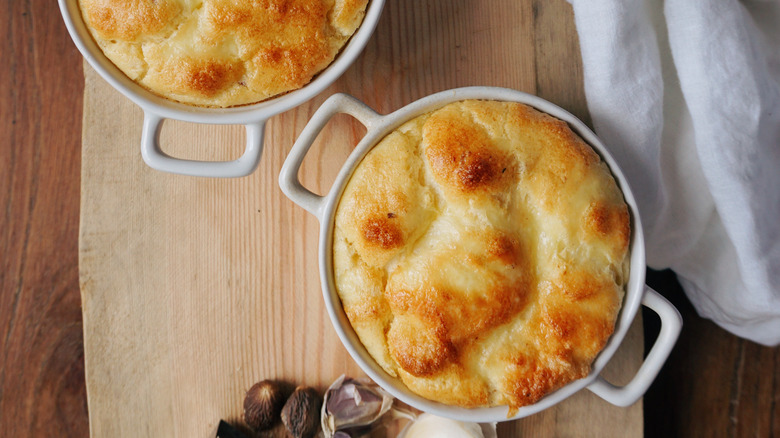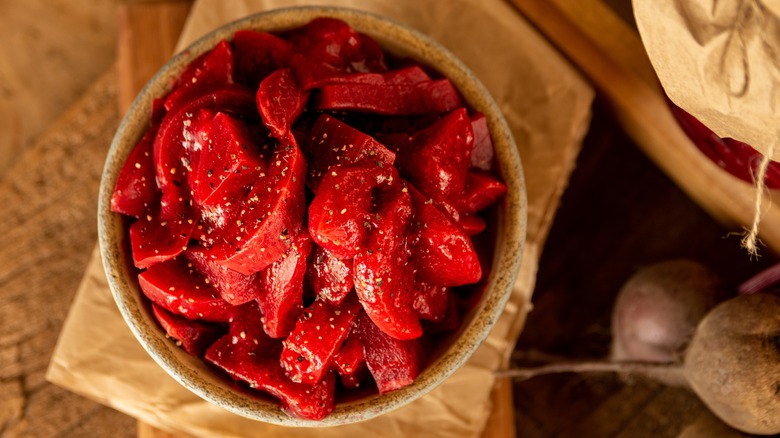Retro Side Dishes We Barely See On The Dinner Table Nowadays
Dinner feels incomplete if you don't have a couple of sides to go along with the main dish. Hearty side dishes not only make your meal taste better but also balance it out. Buttery mashed potatoes, dinner rolls, roasted classic vegetables, simple salads, and even good old fries are a few options that most folks love and prefer today. But if you grew up in the late 20th century, you probably have memories of your dinner table often being packed with a bunch of side dishes that we barely see these days. Sure, some of them were outright odd, and you're possibly glad they've fallen out of favor. However, when it comes to a few others, you might as well be wondering, "This dish was so delicious — why doesn't anyone make it anymore?"
As it turns out, changing preferences did cause a few popular side dishes from yesteryear to fade into obscurity. Plus, back in the day, a lot of sides were made by simply mixing together ingredients that were readily available and affordable. Now that a wider variety of ingredients are easier to get, folks have moved over to the options we see today. That being said, we think it's about time these dishes (or, most of them, anyway) made a comeback, and for that, we've come up with a list of some fantastic retro sides. Stick around if you're looking to take a trip down memory lane or want to bring something old-school to your next dinner party.
Savory Jell-O salads
Long before tossed salads made with fresh greens and light dressings took over, savory Jell-O salads were all the rage. These salads were believed to be inspired by the old-school "perfection salad," which was likely the first popular gelatin-based savory salad.
Savory Jell-O salads really peaked in popularity in the mid-20th century when convenience foods had started taking over. Plus, Jell-O launched a few wild flavors (now discontinued) around the same time, which got people excited to experiment with them and try out new combinations. Also, let's not forget that the company released various recipes for savory salads in that era itself, hopping on the bandwagon. All of these factors together turned Jell-O salads into the ultimate side dish that often showed up on dinner tables. But these savory salads eventually saw a decline and then mostly vanished, as in the '70s people's preferences shifted toward healthier options.
Sure, you may be glad that Jell-O salads aren't in vogue anymore, as most of them were pretty wacky. However, a few weren't as strange and are still worth trying out. For instance, Jell-O released a recipe for an emerald Macédoine salad in 1952, which called for ingredients like stuffed olives, green peppers, and celery, all inside of lime-flavored Jell-O. If you're into foods that have a bit of zing, you should give this retro side dish a shot.
Scalloped corn
Believed to be from New England, scalloped corn was quite a staple side dish in the mid-20th century across the country. Like scalloped potatoes, the corn is layered and baked with cream and butter. Recipes for scalloped corn usually varied from one family to another — some folks preferred making the dish with fresh corn kernels or tinned kernels, while others used creamed corn instead. Similarly, the dish was topped with either crushed crackers or breadcrumbs based on personal preferences. Overall, scalloped corn was easy to make and quite hearty, which is exactly why it's worth bringing back. Plus, this dish is a great Thanksgiving recipe or a way to switch things up if you're bored of the same old corn-based sides.
To make scalloped corn, start by sauteing corn kernels with onions, celery, and bell peppers. In case you're using frozen corn, avoid boiling it even if the package says so, as it can strip away most of the nutrients. Instead, just thaw the kernels and saute them right after. Then, toss the sauteed veggies in a simple white sauce (like béchamel). Then, transfer everything to a scalloped dish. In case you don't have one of those, a regular casserole dish will work, too. Some recipes have you butter the dish or add crackers to the bottom before adding the corn, but this is optional. Top it with crushed crackers or breadcrumbs, and bake until golden brown.
Stuffed onions
Despite onions having a lovely piquant flavor, they are sidelined in most side dishes. But stuffed onions from yesteryear actually made the bulbous vegetable the star of the show. This was a staple food during the Great Depression, mainly because onions were cheaper than other vegetables. Plus, stuffing them was a convenient way to make a side that would be filling enough for an entire family.
The filling for stuffed onions was usually made with whatever people could afford back in the day. As many families were financially strained in the 1920s through the 1940s, onions were typically stuffed with a combination of budget-friendly ingredients like stale breadcrumbs, lemon rind, ketchup, cheese, and a few spices. The dish evolved a few decades later, as fancier food products became more affordable. For instance, a recipe for stuffed onions featured in a cookbook called "Casserole Cookery" in 1943 called for higher-end ingredients like bacon and veal. Cheese is always a good addition to this dish, too.
Given the versatility of stuffed onions, it's sad that they're barely seen on dinner tables now. But if you genuinely like the flavor of onions, you should consider giving this old-school side dish a shot. You don't need to follow a particular recipe either. It's best to stuff them with meat (like bacon or ground beef), cheese (like cheddar or tangy feta), breadcrumbs, seasonings, and some diced veggies (like celery or carrots), but you can get creative with these.
Glazed carrots
We wouldn't say glazed carrots have completely vanished — the dish has retained its popularity in Europe, particularly as part of roast dinners. But most Americans today remember this side dish with French roots as something their grandmas made when they were kids.
Glazed carrots were a regular feature on dinner tables in the United States in the 1900s. They were particularly loved for being easy to prepare. Plus, they looked pretty fancy. Though it isn't clear why this side dish isn't in vogue today, it's likely because a lot of folks found it excessively sweet, which is partly true. Many old-school recipes for glazed carrots suggested cooking sliced carrots with only water, sugar, and butter, which, let's just say, could have been a bit too one-note.
But the good news is that there's more than one way to glaze a carrot. You can easily customize the dish to your liking, making it a side that's definitely worth bringing back. Slice the carrots into diagonal chunks about the size of your thumb, and coat them in vegetable or olive oil. Focus on the savory side of the dish by adding in spices and herbs, like fresh thyme or rosemary. Similarly, try replacing the sugar with honey or maple syrup for an earthy finish, and toss in umami-rich ingredients like soy sauce or Worcestershire sauce to cut the sweetness further. Serve them alongside meat for a delicious and balanced meal.
Wilted lettuce salad
Wilted lettuce salad is a retro side dish that may not seem too appealing from the get-go, but it isn't nearly as unappetizing as its name suggests. The salad wasn't made with actual wilted lettuce. Instead, the leafy greens were topped with a dressing made of hot bacon grease. That's essentially how this side dish got a slightly off-putting yet apt name, as the hot grease would make the lettuce wilt.
While there isn't solid proof to back this information up, it's believed that this salad was first made by people from the Pennsylvania Dutch community or German immigrants, a relic from an era when people didn't waste leftover ingredients like bacon grease. Along with lettuce and a bacon grease-loaded dressing (which also contains vinegar and sugar), wilted lettuce salad also often featured bacon bits and hard-boiled eggs, but these additions usually varied from one region to another.
Though wilted lettuce salad didn't make its mark across the United States even back in the day, it was a go-to in states like North Carolina, Tennessee, and Kentucky, where it was also called "kilt lettuce." But its prevalence has mostly faded, even in these states. Nonetheless, if you're intrigued by how a hot bacon grease dressing would taste, this retro side dish is worth a try. To give it a modern twist, you can even air-fry your lettuce leaves for an extra-crispy finish before adding the dressing.
Succotash
You might remember Sylvester the cat from Looney Tunes often exclaiming "Sufferin' Succotash!" That's probably the only memory most people who grew up in the '80s and '90s have of this once beloved stew-like side dish. While succotash was quite a staple throughout the mid-1900s, its roots go way back to the 17th century.
This dish was originally called msickquatash by the Native Americans, for whom it was more of a main dish rather than a side. That explains why the traditional version was made with a medley of hearty and filling ingredients like squash, beans, and corn. It is believed that Native Americans had variations of the dish with added ingredients like meat, nuts, fruits, and shellfish, to name a few, and they also sometimes tossed in other seasonal vegetables — but corn and beans were always featured. Later, they introduced the dish to early European settlers, who eventually started making their own versions of succotash and also transitioned to serving it as a side dish.
If succotash was once your favorite side or if the recipe sounds intriguing to you now, you should consider making it at home. Just mix together corn and beans and simmer with some of your favorite veggies, spices, seasonings, and herbs. Corned beef, salt pork, and white fish are often added to elevate the dish to entrée status.
Onion soufflé
As you may have guessed, onion soufflé was indeed inspired by the classic French soufflé. The dish was supposedly at its peak in the 1950s and '60s, when cheese soufflés were popular among high-society folks. Recipes for this side had actually started appearing in cookbooks much earlier, with one of the first ones dating back to 1899.
To prepare a classic onion soufflé, chop onions, cook them, mix them with béchamel sauce, milk, breadcrumbs, and egg yolks. Fold in some egg whites, and lastly, bake until it puffs up. The result is a side dish with a light texture and a sharp yet creamy flavor. While this was one of the earliest recorded recipes, people eventually started experimenting with the dish and began publishing their own versions in cookbooks. For instance, a recipe featured in "The Housewife's Cook Book" in 1917 listed melted butter as an ingredient instead of béchamel sauce and milk. Similarly, a recipe that was published in a cookbook called "The New Cookery" in 1921 called for onion puree along with chopped onions. Though ingredients sometimes varied, the final dish always turned out fluffy and delicious.
Mashed turnips
Given that mashed turnips are easy to prepare and taste fantastic, it isn't surprising that they were an admired side dish once upon a time. The root vegetable arrived in America via European settlers, and though it's no longer popular in the U.S., mashed turnip is commonly eaten in the U.K. in the colder months. The earliest recorded recipes for this side dish in America were pretty simple, and they usually called for standard ingredients like a bunch of turnips, salt, pepper, and butter.
While it's hard to pinpoint when mashed turnips were at their peak in the United States, we know they were usually consumed around Christmas. However, they are worth revisiting if you'd like to mash something other than potatoes. All you have to do is boil turnips until they are tender, mash them well so you can get rid of any lumps, and then toss in some fat and seasonings of your choice. Using fresh herbs and spices, browned butter, soft cheese, garlic, and bacon bits are all great ways to elevate the dish. Serve mashed turnips alongside meat and vegetables for a truly hearty meal.
Harvard beets
Let's face it — most people either love beets or detest them. But if you fall in the former category, you're bound to find Harvard beets from yesteryear pretty appealing. This side dish took America by storm in the early to mid-20th century. One of the best things about Harvard beets was that they were easy to put together. All you have to do is roast the beets, then peel and slice them. Simmer them slowly in a sauce made with sugar, water, vinegar, salt, and cornstarch until tender. Some old-school recipes were even simpler, as they only suggested making a sauce and pouring it over cooked sliced beets.
As for its roots, it's believed that this side dish was first made in England and later made its way to the United States. (It's unclear where the name "Harvard beets" came from.) But after making their mark in the country, Harvard beets eventually went out of style. Nonetheless, what's forgotten can definitely be brought back, especially if you think beets are underrated. You can follow one of the old-school recipes or customize it with extra herbs and spices. We recommend adding some cinnamon, nutmeg, and ginger to the sauce for a soothing heat and replacing the white sugar with brown for a malty flavor. Also consider using the beet greens — as you should technically be eating them and not throwing them out — for added nutrients and earthy flavor.
